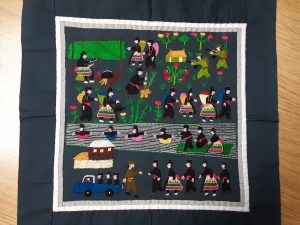Today I had the privilege to sit with a story cloth that was hand stitched by a Hmong woman in 2002. Story cloths, or paj ntaub in Hmong, are embroidered fabric squares made to narrate and preserve history.¹ In particular, Hmong people living in refugee camps in Thailand in the 1970s began creating these works to depict the stories of their displacement and migration that brought them to those camps.² During the Cold War, the Hmong people became embroiled in the conflict in Laos with the CIA, U.S. military, and “aid” organizations.³ Hmong people then faced persecution by the leftist government that came to power after formal conflict had ceased.⁴ Nearly 150,000 Hmong and other ethnic groups in Laos escaped to Thailand and were resettled around the world, mostly in the U.S.⁵ The Hmong Archives, which are housed at the East Side Freedom Library in St Paul, MN, has an extensive collection of the history of that resettlement including hundreds of story cloths.⁶

The cloth I examined today tells the story of some Hmong individuals crossing the Mekong River, the border between Laos and Thailand. The top half of the cloth features bright flowers and trees. There are a few small structures and on the far left side and people are shown cooking, planting crops, and going about their daily lives. In the top right corner two government soldiers are shown aiming guns at the civilians. Crossing the middle of the cloth is an embroidered river, presumably the Mekong. People are shown swimming across it, others are on a raft. At the bottom of the cloth individuals are shown arriving in in Thailand, being greeted by U.S. American soldiers, and taken by truck to a refugee camp. The context to understand the images in this cloth has been recorded in interviews with resettled Hmong individuals who discuss the events outlined in the story cloth.⁷
Although hundreds of these histories have been preserved, the handful I saw at the library today shared narrative and visual elements with the one I studied. I was struck in particular by the similarity of the clothing worn by the people in all the story cloths I saw. Upon doing some research I learned that the traditional Hmong dress depicted, is adorned with a style of embroidery quite similar to that which is used in making the cloths and which is a celebrated art from in that culture.⁸
Linear time is blurred by the form of this history. It is hard to tell, studying the story cloth, whether we are watching the progression of a few people through linear time and space, or looking at a moment in time in which several people are at various stages of a journey simultaneously. In spite of the static nature of the medium, change and movement read clearly. On the one hand, the people are depicted in active stances of walking, swimming, and working. Additionally, there is a subtle shift in facial expression from the people in the top left corner who are smiling, going about their day, and those people traveling away from home who’ve realized the threat they face in staying. Whether the story is multiple narrative simultaneously or one evolving through time, the progression is clear. Everyone seems to move from their daily life at home through an arduous journey of escape to uncertainty at the military base in Thailand.
The story cloth as a medium makes the telling and preserving of history a diffuse process. Every person who embroiders one of these histories can tell their story as they see fit, instead of having designated individuals deemed qualified to “write” history. This practice problematizes on the history we practice at Macalester, and in the academy generally, which privileges the view of formal, academic historians over the perspective of others in society. Conversely, many of the early forms of oral history we studied in class focused on the lives of Gods, heroes, and rulers. The story cloths differ, powerfully, in the sense that they represent people’s history, not merely the history of a few “great men.”
1. Chia Youyee Vang, Hmong in Minnesota, (St Paul: Minnesota Historical Society Press, 2008), 49.
2. Ibid., 49.
3. Ibid., 2, 6.
4. Ibid., 2, 6.
5. Ibid., 11.
6. Hmong Archives, “About,” http://hmongarchives.org/about/.
7. Vang, 7-9.
8. Xai S. Lor, “Words of Acknowledgment for the www.HmongEmbroidery.org Project and a brief history of Paj Ntaub,” https://www.hmongembroidery.org/.
You must be logged in to post a comment.